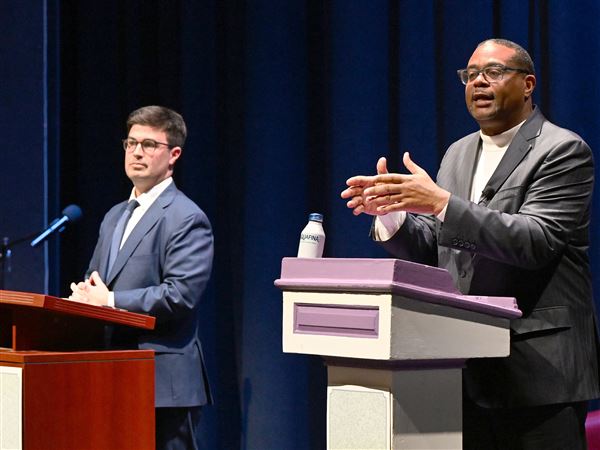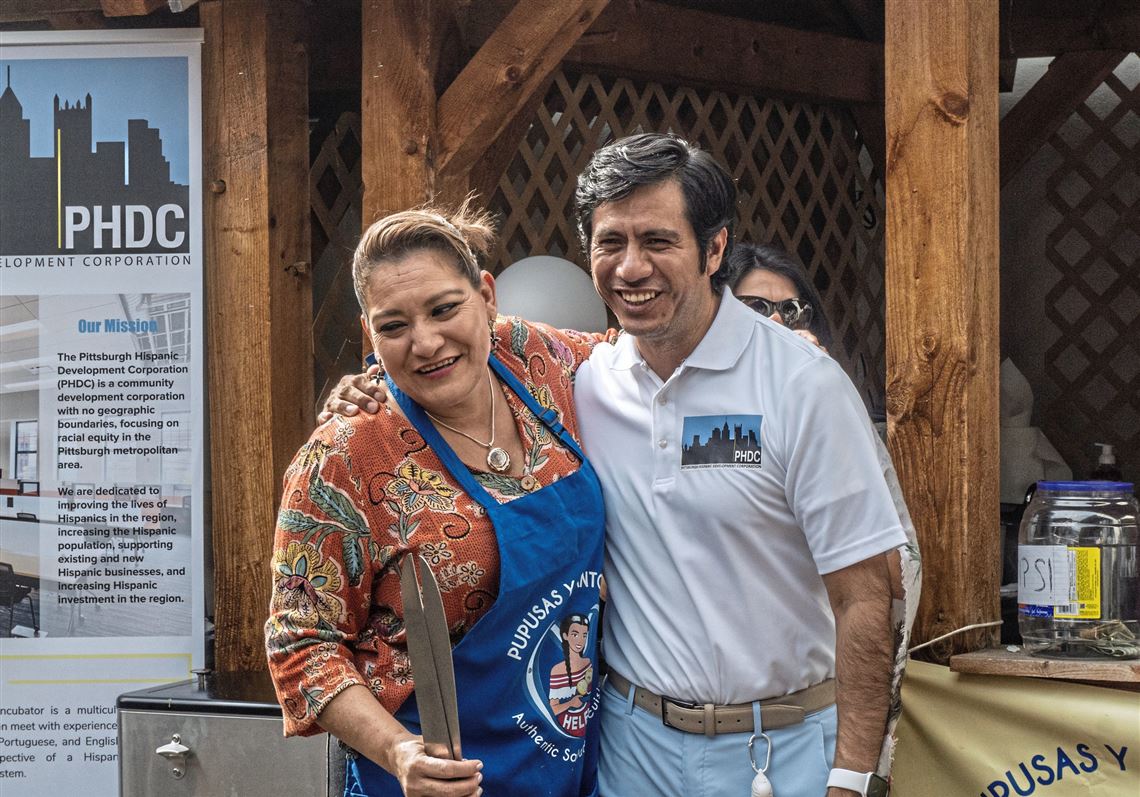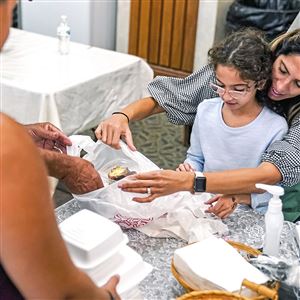During the eight years Blanca Helen Martinez worked long hours in restaurants around Pittsburgh, the 48-year-old harbored a dream that began in her native El Salvador.
For Ms. Martinez, opening a Pupusa restaurant in America would be a step up from her previous employment. In El Salvador, she raised chickens on a farm, taking the weekends to craft her own rendition of the national dish, a savory, meat-stuffed corn tortilla.
But her goal came with barriers; without a firm grasp of English, applying for a business license, dealing with health inspectors, and filing taxes for her newly opened Strip District Pupusa stand proved a challenge.
So Ms. Martinez got connected with Pittsburgh Hispanic Development Corporation, a nonprofit in Beechview — the sleepy, South Hills city neighborhood that’s grown to become the region’s de facto hub for the growing Latino community. The group soon stepped in to help her translate the mountains of documents needed to launch Pupusas y Antojitos Helen on 19th Street.
To Guillermo Velazquez, the group’s executive director, Ms. Martinez’s story is inspiring but far from unique. In the past year, a wave of Latino businesses have launched around Pittsburgh, many of them by Beechview residents. It’s partly the result of a decade of rapid immigration to the neighborhood, where the Latino population has quadrupled this century in a wave of expansion from one of Western Pennsylvania’s least-represented ethnicities.
“We didn’t know that there was going to be so much demand from the community,” said Mr. Velazquez, who’s led the organization since 2016. “There’s five of us, and I wish there were 10.”
According to statistics collected by the nonprofit, it’s easy to see why his small team is so busy.
Around 17% of the region’s Hispanic population now lives in Beechview. A bulk of families hail from Mexico, Venezuela, and Colombia, marking a shift from the neighborhood’s roots as a hub for Italian, Irish, and Jewish immigrants during the early 20th century.
Overall, the neighborhood’s makeup is nearing 10% Hispanic — four times as large as it was in 2000. Compared to the whole of Pittsburgh, where just 3.8% of the population is Hispanic, these figures demonstrate just how tightly concentrated the community has become.
What’s made the neighborhood so attractive is its location along the Red trolley line, according to Mr. Velazquez, creating an efficient route for residents to travel into Downtown and surrounding areas for work. He also attributes these immigration patterns to word-of-mouth stories of success that Beechview residents share with friends and family throughout the country.
Who’s found that success? Cleaners and roofers, painters and restaurateurs, mechanics and hair dressers are all among the 78 businesses the Hispanic Development Corporation has helped incorporate through its business incubator program.
The program has had ripple effects throughout the community; those companies have since hired 71 full-time and 53 part-time employees, many from the Beechview community.
For Ms. Martinez, the incubator carved a path toward gender-equality in entrepreneurship, incorporating 21 women-owned businesses since its inception.
“I feel that it’s a really nice experience to share with other people,” Ms. Martinez said through a translator. “I just feel proud about it, just to be able to advance myself.”
Ms. Martinez worked with Mr. Velazquez for around two years to bring Pupusas y Antojitos Helen to reality, a period that spanned the worst of the COVID-19 pandemic.
During that time, the group incorporated just 15 companies. But as the city has adapted to living alongside the virus, Mr. Velazquez has seen demand for new Hispanic businesses double — in 2021, that number jumped up to 30, and this year the group has incorporated up to three businesses per month.
“After the pandemic, a boom started to happen,” Mr. Velazquez said. “[People] who were working in certain industries. Now they were forced to work in something else. People became more aware of opportunities. Also, people became more aware that we were around, that we were helping people to correctly start their companies.”
Many of these changes are happening along the neighborhood’s main business corridor. On the trolley-lined curvature of Broadway Avenue, storefronts that were long shuttered are reopening their doors as Mexican and El Salvadoran eateries. Other venues include a Central American barber shop, and the soon-to-be-opened Latino Food to Go.
Across the street from the Hispanic Development Corporation’s two-story office, the scent of street tacos wafts from local favorite Las Palmas, attached to the bustling IGA market, a Hispanic grocery that anchors the surrounding community.
Those are just the storefronts. Just minutes down the road at Belasco Street and Broadway, the 120-year-old St. Catherine of Siena now offers Mass in Spanish and Portuguese. Nearby, the social services center Casa San Jose offers programs to help Latinos with issues involving immigration law, language learning, mental health, and more.
According to Missy Berumen, who helps run the Las Palmas and IGA market and taco stand on Broadway, having a central hub for the Latino community was essential to building Beechview’s character.
In the late 2000s, Ms. Berumen and her husband moved to Pittsburgh looking for work amid the post-9/11 recession. In their hometown Indianapolis, they found too much competition from other markets, but saw Pittsburgh’s lack of a Latino grocer as an opportunity, and have since opened several Las Palmas locations along with managing IGA.
The market has since given the community has access to Hispanic foods that are harder to find in Pittsburgh grocers, like El Milagro corn tortillas and Cecina, a salted and dried meat that’s a specialty in Mexico.
But Ms. Berumen was quick to note that the Latino community is visible and growing beyond Beechview. According to statistics from the Hispanic Development Corporation, Mount Oliver and Mount Washington have also seen upticks in their Latino population, as well as in Coraopolis.
And while new businesses are flourishing after the worst of the pandemic, that period also came with its challenges for the community.
Over the past two years, the Hispanic Development Corporation helped Latino community members apply for Allegheny County’s emergency rental assistance program, which prevented evictions as workers struggled to pay their rents amid job losses and industry shutdowns.
According to statistics from the U.S. Bureau of Labor Statistics, the unemployment rate among the country’s Hispanic population jumped from around 4% before the pandemic to 18% by April of 2020.
This work was important, according to the group, because Latinos without citizenship did not qualify for the federal stimulus payments that kept others afloat during the period.
Other challenges existed before the pandemic. With the group, Ms. Figueroa works to secure community members with individual taxpayer ID numbers, allowing them to pay taxes without having a Social Security number.
But that process involves going to the federal IRS offices, which she said some Latino community members were fearful of visiting because of their immigration status. That was another challenge the Hispanic Development Corporation assisted with, and Ms. Figueroa now tags along on these visits to ease the process along.
“We’re helping new Latino businesses start in a community that has been historically underserved,” Mr. Velazquez said. “We’re very happy that we’ve reached 10 years. It’s been a journey — but it’s a good thing for the community and a good thing for Pittsburgh overall.”
First Published: September 17, 2022, 10:00 a.m.
Updated: September 18, 2022, 2:52 a.m.






















